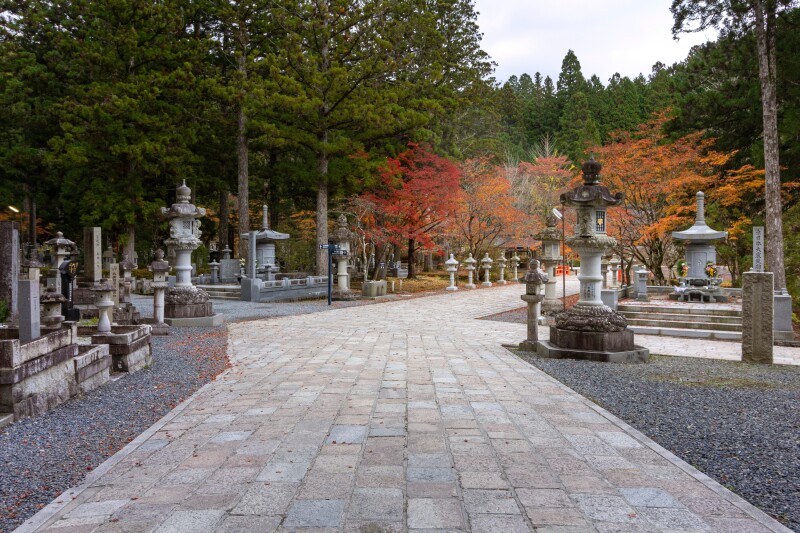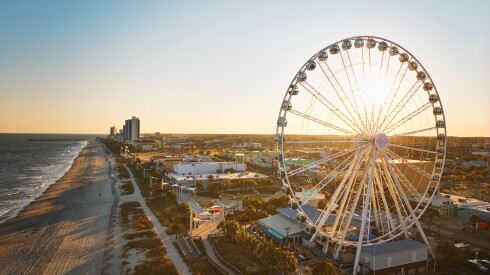When it comes to seasonal highlights, Japan might be best known for its wave of pink cherry blossoms, or sakura, in spring. But its fall counterpart—the koyo, referring to the autumn phenomenon of colorful fall foliage—is just as stunning. From Hokkaido in the far north to Kyushu in the southwest, fiery maples and golden gingko repaint much of the country between October and early December, starting in the north and the mountains before reaching southern and lowland regions. Whether you want to enjoy momijigari (fall-leaf searching) with a hike in a national park or prefer to simply gaze upward while soaking in an outdoor hot-spring bath, here are eight places to go in Japan for gorgeous fall foliage.
Kurobe Gorge, Toyama
When to see fall foliage: late October to early November
Toyama Prefecture, a couple hours’ train ride northwest of Tokyo, doesn’t end up on most travelers’ Japan itineraries. In the fall, though, this part of the Hokuriku region delivers some of Japan’s finest seasonal foliage. The best of it is visible on a sedate train ride on the open-air Kurobe Gorge Railway, which traces the emerald Kurobe River between the rural hot-spring towns of Unazuki and Nekomata on a route engulfed by deep red maples. The languid trip takes roughly two hours round-trip and costs approximately $19 (¥2,820); for a shorter ride of around 50 minutes round-trip, hop off in Kuronagi (US$11/¥1,660).
Where to stay
- Book now: Yamanoha
The train departs from Unazuki Onsen, where you’ll find traditional ryokan inns like Yamanoha, which has a mix of 142 Japanese-style and Western-style rooms, plus a kids play area, ping-pong corner, tea lounge, and communal hot-spring baths with panoramic views of the Kurobe Gorge.

Rikugien Gardens is especially known for its maple leaves.
Photo by Phinnasan/Shutterstock
Rikugien Gardens, Tokyo
When to see fall foliage: late November to early December
Forget Tokyo’s reputation for being all high-rises and neon; the capital also has fantastic gardens and natural spaces. That includes Rikugien, a sprawling stroll garden designed in the early 1700s based on themes from classical waka poetry. In fall, it’s one of Tokyo’s top koyo sites, in large part thanks to evening light shows that illuminate the foliage. That also means it gets busy, so if crowds aren’t your thing, try a walk through the Todoroki ravine in urban Setagaya or a weekday hike around Mount Takao in western Tokyo. Rikugien has lockers big enough for suitcases so you can even stop here on your way to or from Haneda and Narita airports (you’ll need a ¥100 coin).
Where to stay
- Book now: Hotel Niwa
There are accommodations closer to the gardens, but Hotel Niwa, about 30 minutes away by subway, has four of its own beautiful, tranquil gardens. Filled with bamboo, maples, and mossy rocks, two of the gardens have water features and one is on the rooftop, where you can take in sweeping views of Tokyo. The mulch that contributes to keeping these gardens so vibrant is made by recycling fallen leaves collected on the property; it’s also used in the rooftop garden, where discarded suitcases act as planters for herbs and vegetables later served at the hotel restaurant. Sleep in one of 229 Western-style rooms with shoji doors and other Japanese accents.
Related: I’m a Tour Guide in Tokyo. These Are My Tips for Avoiding the Crowds in Japan.

Arashiyama is best known for its bamboo grove, but come in autumn for its color-changing leaves.
Photo by Torjrtrx/Shutterstock
Arashiyama, Kyoto
When to see fall foliage: mid-November to early December
On the west side of Kyoto, Arashiyama is best known for its incredibly crowded bamboo grove, although in fall the attention turns to the autumnal hues along the banks of the Hozugawa River. One easy way to take in the views is with a scenic train ride upstream on the Sagano Scenic Railway, followed by a trip back downriver on a flat-bottomed boat guided by a pilot wielding bamboo poles.
Away from Arashiyama, you could also see the koyo in traditional settings, like Tofukuji and Eikando temples or Kitano Tenmangu Shrine. Just be aware that, Kyoto being Kyoto, the top fall sites attract big crowds.
Where to stay
- Book now: Hoshinoya Kyoto; Kyoto Karasuma Rokkaku
Splurge on a night at the 25-room Hoshinoya, right next to Arashiyama and overlooking the river, where you’ll wake to a thicket of fiery trees. Kyoto’s plushest contemporary ryokan offers elaborate kaiseki dinners and cultural activities such as Zen meditation and ikebana flower arranging. For an onsen, or hot spring, experience right in the city center, book a room at Kyoto Karasuma Rokkaku, less than 10 minutes’ walk from Nishiki Market and about 35 minutes by train from Arashiyama. In addition to the hotel’s shared indoor and outdoor baths, the hotel has twin and king rooms with their own soaking tubs.

From Lake Kawaguchi, you can see Mount Fuji.
Photo by Jo Panuwat D/Shutterstock
Lake Kawaguchi, Yamanashi
When to see fall foliage: early to mid-November
Take the Fuji Excursion train two hours west of Tokyo to Lake Kawaguchi, where fall colors meet up-close views of Japan’s most iconic peak, the 12,388-foot Mount Fuji. Among the fall highlights is the Momiji Tunnel on the north side of the lake, where a snow-capped Fuji is framed by deep-red maples. Cruise around Kawaguchi or neighboring Lake Saiko in a canoe or kayak, which you can rent from nearly any hotel as well as outfitters like Country Lake Systems and RobRoy. For an on-land activity, stop by the Itchiku Kubota Art Museum on the lake’s northeastern side to see its striking collection of kimonos; some of them depict Fuji through the seasons.
Where to stay
- Book now: Fufu Kawaguchiko
For Fuji and lake views, stay at the suites-only Fufu, a luxury property that offers outdoor activities such as canoeing and hiking trips. All 32 rooms have onsen baths and walls of glass doors that lead to balconies with views of Mount Fuji and the surrounding forest.

Shikotsu-Toya National Park covers around 400 square miles.
Photo by stockphoto mania/Shutterstock
Jozankei, Hokkaido
When to see fall foliage: early to late October
The northern island of Hokkaido gets some of the earliest fall foliage in Japan, especially across its six national parks. While some spots are fairly remote by Japan’s standards, the hot-spring resort town of Jozankei, set in a wooded ravine in Shikotsu-Toya National Park, is a 35-minute drive from downtown Sapporo. The 246,000-acre park is stunning when surrounded by seasonal reds and yellows, especially when viewed from one of Jozankei’s outdoor hot-spring baths.
Where to stay
- Book now: Furukuwa
Stay at Furukawa in the center of Jozankei, a ryokan with indoor and open-air baths, multicourse kaiseki dinners, and 52 rooms with warm lighting, wooden and tatami flooring, and seating areas for sipping green tea.

Okunoin Cemetery is one of Japan’s most sacred sites.
Photo by Carlos Neto/Shutterstock
Koyasan, Wakayama
When to see fall foliage: late October to early November
The home of Shingon Buddhism since the 800s, the sacred mountaintop town of Koya (or Koyasan) is magical when its temples and gardens—some of which are UNESCO World Heritage sites—are accented by colorful gingko and maples. Two and a half hours south of Osaka by train, it’s a long if doable day trip, but the experience is much more immersive if you stay overnight. Of Koyasan’s 117 temples, 50 or so have accommodations. After the day-trippers head off, take an evening stroll through the wonderfully eerie Okunoin, a vast wooded cemetery home to some 200,000 graves and moss-covered statues.
Where to stay
- Book now: Ekoin Temple
Monastic digs these are not. The 29 shukubo (temple accommodation) rooms at Ekoin are done up in blonde wood and have garden views, comfortable beds, and large bathtubs. Enjoy plant-based shojin-ryori (Buddhist cuisine) and the opportunity to join monks for morning rituals.

Towada-Hachimantai National Park offers plenty of places to admire colorful leaves in the fall, such as Lake Towada.
Photo by Omjai C/Shutterstock
Hachimantai, Iwate
When to see fall foliage: mid- to late October
In Towada-Hachimantai National Park, on the northeastern coast of Honshu, Japan’s main island, stratovolcano 5,292-foot Mount Hachimantai and its neighboring peaks explode with yellows, oranges, and reds for a few weeks in early fall, before heavy snow comes in. Those fleeting, vibrant days are the perfect time for hiking through a mix of wooded mountainside, barren volcanic landscapes, and marshland, with stops at some of Japan’s most rustic hot springs.
Where to stay
- Book now: Toshichi Onsen
Perrched 4,593 feet up the Hachimantai plateau is this no-frills traditional onsen hotel. There are 26 rooms with tatami mats, six of them with their own bathrooms, plus one room with a Western-style single bed. Breakfast and dinner make good use of an array of mountain vegetables, including bamboo. The hotel’s best feature is its cloudy outdoor hot-spring baths from which you can stargaze at night.

At 5,673 feet, Mount Daisen is the tallest peak in western Japan’s Chugoku region.
Photo by Yasubei/Shutterstock
Mount Daisen, Tottori
When to see fall foliage: late October to early November
Mount Daisen becomes a patchwork of colors in fall. The “seven-colored peak,” as locals call it, is thickly covered by maple, beech, oak, Japanese rowan, and other trees that in turn produce various shades of red, yellow, gold, and orange starting in late October. Before hiking, you can get trail info at the Daisen National Park Center in the village of Daisen at the foot of the peak. To get here, fly from Tokyo to Yonago (80 minutes) and then catch an hour-long bus; you can also take the train from Osaka to Yonago, changing in Okayama, in less than 3.5 hours.
Where to stay
- Book now: Hotel Itadaki
A block from the river in the village of Daisen is Hotel Itadaki, a modern apartment-hotel with two spacious suites, each with two beds (though not two bedrooms). Both have balconies looking toward the Bay of Miho on which you can take in a gorgeous sunset and even have a barbecue; the hotel will gather all the ingredients and get you set up.
Related: 13 Essential Dishes to Try in Japan
This article was originally published in 2024 and most recently updated on August 26, 2025, with current information. Sophie Friedman contributed to the reporting of this story.











